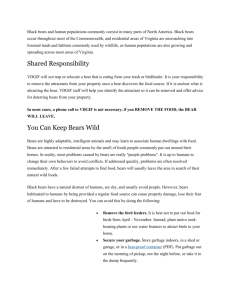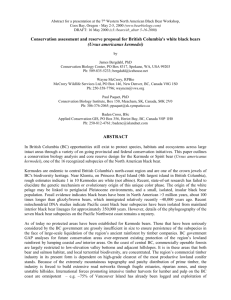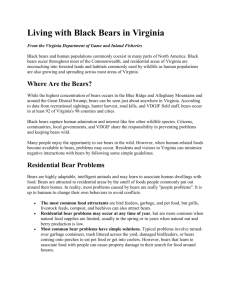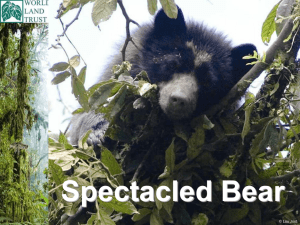my powerpoint on the malayan sun bear
advertisement
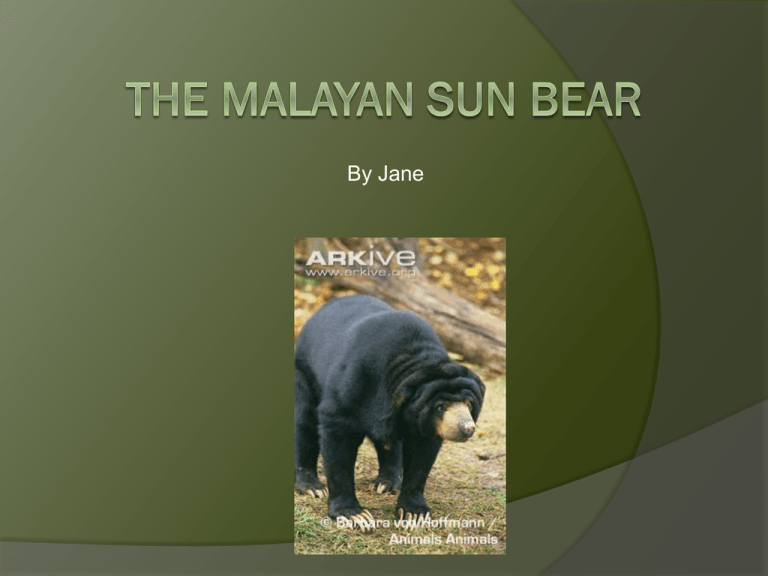
By Jane Physical Characteristics The Malayan sun bear has short, deep black or brown-black hair with a pale orange-yellow horseshoe shaped marking on its chest. Adult sun bears can weigh from 60-150 Ibs. Baby sun bears weigh only 10-15 ounces when they are born. The males are usually 5 feet long and the females are usually 4 feet long. The Malayan sun bear is the smallest bear in the world! Reproduction Gestation is usually 96 days. One or two cubs are born at a time. The babies are naked, small, and helpless so the mom cares for them. The young stay with their parents for about two to three years. Habitat The Malayan sun bear lives in many lowland tropical areas like countries in Asia such as China, Burma, Malaysia, and Vietnam. The sun bear is arboreal and makes its nest in trees. Sun bears are not territorial. Food The sun bear is an omnivore, which means it will eat almost anything. The diet of a sun bear may include termites, ants, beetle larvae, bee larvae, honey, fruit, small rodents, and lizards. Video of Sun Bear Eating Hard Fruit (Click on video to start) Interesting Facts Sun bears have very loose skin on the back of their necks, so they can easily turn around and defend themselves if they are bitten by an attacker. When the sun bears are young, they are playful and are sometimes kept as pets in Asia. Video of Playful Sun Bears (Click on video to start) Threats to Survival Predators of the sun bear include other bears, tigers, clouded leopards, and humans. The Malayan sun bear is endangered because of poaching and destruction of its habitat. Pictures Six-month-old sun bear Full grown sun bear Physical Adaptations Physical Adaptation How it Aids Survival Loose skin on back of neck Helps them escape and fight off predators Dark fur Blends in with habitat, especially at night Long tongue Helps them sip up nectar and get bugs out of wood Feet point slightly inward Helps them climb trees Large, naked paws Helps them climb trees Long, curved claws Helps them climb trees Extraordinarily large feet Assists with digging and breaking into dead wood in search of insects Short hair Keeps them cooler in tropical climates Large jaws Helps them break open hard fruit like coconuts Large canine teeth Assists in defending against predators Video Showing Physical Adaptations (Click on video to start) Behavioral Adaptations Behavioral Adaptation How it Aids Survival Does not hibernate Food is available yearround Becomes more nocturnal in areas near humans Helps them avoid human hunters Makes barking sound when threatened Scares away predators Rises up on hind legs when threatened Makes it look bigger and helps scare away predators Builds nests in trees Keeps them away from predators and closer to their food source Cleveland Zoo Habitat (Click picture to start video) Suggested Improvements to Cleveland Zoo Habitat Put sun bear inside a heated space, because their natural habitat is warm and tropical The habitat should also be darker, because sun bears are mostly nocturnal when near humans Include trees for the sun bear to climb since they are arboreal. Give the sun bear a ball to play with, since sun bears are playful Suggested Improvements, Continued Get another sun bear, because they are social animals and are lonely without other bears Include a source of nectar, so the bear can use its long tongue







